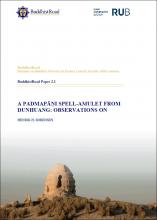BuddhistRoad Paper 2.1 "A Padmapāṇi Spell-Amulet from Dunhuang: Observatio on OA 1919,0101,0.18"
Synopsis
This article throws light on a slightly unusual example of a trans-cultural artefact, namely a dhāraṇī-amulet, which in this case features the imprint and creative designs of both Tibetan and Chinese Buddhist cultures, even though its basic iconic components remain rooted in Indian Buddhism. Although not unique among the Dunhuang material, it is a fascinating and slightly curious example of how Buddhism served as a common denominator for Buddhist practitioners of both cultures during the period of the Tibetan rule of Shazhou (沙州), i.e. roughly between the late 750s/early 760s and 848. The example discussed here is from the collection of the British Museum, and has for unknown reasons hitherto escaped the notice of the scholarly community.
Chinese Translation
本文介绍了一件略显奇特的跨文化工艺品, 即一个陀罗尼护身符 (dhāraṇī-amulet), 它具有藏传和汉传佛教文/ 中国佛教化的印记和创造性设计, 但其基本的标志性成分仍然源于印度佛教. 尽管它在敦煌文物中并不独特, 但却是一个迷人且略微特别的例子, 说明了在西藏统治沙州期间 (约750年代末/760年代初至848年之间, 佛教如何成为两种文化的佛教徒的共同标准. 该工艺品为大英博物馆的收藏, 不知缘何尚未引起学术界的注意.

Downloads
Published
Categories
License

This work is licensed under a Creative Commons Attribution-NonCommercial-NoDerivatives 4.0 International License.

